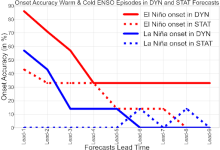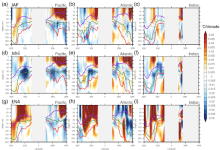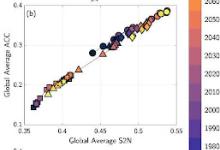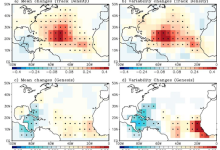Research Highlights
We aim to feature the latest research results from US scientists whose published paper features work that is sponsored by one or more sponsoring agency programs of US CLIVAR (NASA, NOAA, NSF, DOE, ONR). Check out the collection of research highlights below and sort by topic on the right. Interested in submitting an article for consideration? See our Research Highlight Submission Guidelines page for more information.
Despite rising greenhouse gas concentrations, sea surface temperature (SST) in the eastern equatorial Pacific has shown little to no warming since the mid-20th century. The peculiar cold tongue response and the associated strengthening of the zonal SST gradient stand in stark contrast to most climate model simulations, which typically simulate enhanced warming in the east and a weakening of the zonal SST gradient. Understanding this discrepancy is critical for improving projections of tropical Pacific climate and its global teleconnections. Jiang et al. (2025) examining long-term trends over 1958 to 2022, identifies a key reason for the mismatch: models fail to generate subsurface cooling through realistic wind-driven circulation changes or to effectively communicate that cooling to the surface through upwelling and mixing.
Ehsan et al. analyzed 253 real-time Niño3.4 index forecasts—a key ENSO indicator measuring sea surface temperature anomalies in the central-eastern Pacific (5°S–5°N, 120°–170°W). The study found that DYN models (multimodal means of dynamical models) outperformed STAT models (multimodal means of statistical models), particularly for forecasts initiated between late boreal winter and spring months—known as the “spring predictability barrier,” a notoriously difficult period for ENSO forecasting. DYN models achieved 60% accuracy in predicting El Niño onsets up to three months in advance, whereas STAT models performed significantly worse.
These findings of significant changes in the seasonality of ocean temperature have potentially important implications for other biological and chemical properties of the ocean, such as the uptake of oxygen and CO2 by the world’s oceans.
In Amaya et al. (2025), the authors use statistical methods applied to five coupled model large ensembles to diagnose whether and how potential predictability is projected to change in the future as a distinct response to anthropogenic climate change. Specifically, they apply the perfect model-analog framework to estimate the seasonal predictability limits of global surface temperature, precipitation, and upper atmospheric circulation from 1920-2100.
This study shows that both unusually active and inactive hurricane seasons have become more common since the 1990s, and computer models predict that by the middle of this century, the variability could increase by an additional 36%, with the biggest increase expected to occur in the central tropical North Atlantic, which refers to the mid-section of the North Atlantic Ocean where tropical storms and hurricanes most frequently form.





